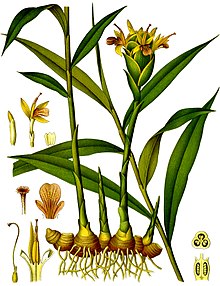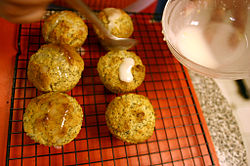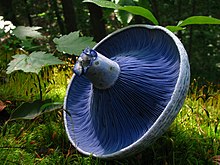
Back بوابة:مطاعم وطعام Arabic প্রবেশদ্বার:খাদ্য Bengali/Bangla دەروازە:خۆراک CKB Portál:Gastronomie Czech Portal:Essen und Trinken German Portalo:Nutrado kaj gastronomio Esperanto Portal:Alimentos Spanish Portaal:Toit Estonian درگاه:خوراک Persian Portail:Alimentation et gastronomie French
F o o d
A portal dedicated to food and foodways
Introduction


Food is any substance consumed by an organism for nutritional support. Food is usually of plant, animal, or fungal origin and contains essential nutrients such as carbohydrates, fats, proteins, vitamins, or minerals. The substance is ingested by an organism and assimilated by the organism's cells to provide energy, maintain life, or stimulate growth. Different species of animals have different feeding behaviours that satisfy the needs of their metabolisms and have evolved to fill a specific ecological niche within specific geographical contexts.
Omnivorous humans are highly adaptable and have adapted to obtain food in many different ecosystems. Humans generally use cooking to prepare food for consumption. The majority of the food energy required is supplied by the industrial food industry, which produces food through intensive agriculture and distributes it through complex food processing and food distribution systems. This system of conventional agriculture relies heavily on fossil fuels, which means that the food and agricultural systems are one of the major contributors to climate change, accounting for as much as 37% of total greenhouse gas emissions. (Full article...)
Cooking, also known as cookery or professionally as the culinary arts, is the art, science and craft of using heat to make food more palatable, digestible, nutritious, or safe. Cooking techniques and ingredients vary widely, from grilling food over an open fire, to using electric stoves, to baking in various types of ovens, reflecting local conditions. Cooking is an aspect of all human societies and a cultural universal.
Preparing food with heat or fire is an activity unique to humans. Archeological evidence of cooking fires from at least 300,000 years ago exists, but some estimate that humans started cooking up to 2 million years ago.
The expansion of agriculture, commerce, trade, and transportation between civilizations in different regions offered cooks many new ingredients. New inventions and technologies, such as the invention of pottery for holding and boiling of water, expanded cooking techniques. Some modern cooks apply advanced scientific techniques to food preparation to further enhance the flavor of the dish served. (Full article...)
Elizabeth David, the British cookery writer, published eight books in the 34 years between 1950 and 1984; the last was issued eight years before her death. After David's death, her literary executor, Jill Norman, supervised the publication of eight more books, drawing on David's unpublished manuscripts and research and on her published writings for books and magazines.
David's first five books, particularly the earlier works, contained recipes interspersed with literary quotation and descriptions of people and places that inspired her. By the time of her third book, Italian Food, David had begun to add sections about the history of the cuisine and the particular dishes that she wrote about. Her interest in the history of cooking led her in her later years to research the history of spices, baking, and ice. (Full article...)
Selected article –

The spice trade involved historical civilizations in Asia, Northeast Africa and Europe. Spices, such as cinnamon, cassia, cardamom, ginger, pepper, nutmeg, star anise, clove, and turmeric, were known and used in antiquity and traded in the Eastern World. These spices found their way into the Near East before the beginning of the Christian era, with fantastic tales hiding their true sources.
The maritime aspect of the trade was dominated by the Austronesian peoples in Southeast Asia, namely the ancient Indonesian sailors who established routes from Southeast Asia to Sri Lanka and India (and later China) by 1500 BC. These goods were then transported by land towards the Mediterranean and the Greco-Roman world via the incense route and the Roman–India routes by Indian and Persian traders. The Austronesian maritime trade lanes later expanded into the Middle East and eastern Africa by the 1st millennium AD, resulting in the Austronesian colonization of Madagascar. (Full article...)Selected cuisine -

Filipino cuisine is composed of the cuisines of more than a hundred distinct ethnolinguistic groups found throughout the Philippine archipelago. A majority of mainstream Filipino dishes that compose Filipino cuisine are from the food traditions of various ethnolinguistic groups and tribes of the archipelago, including the Ilocano, Pangasinan, Kapampangan, Tagalog, Bicolano, Visayan, Chavacano, and Maranao ethnolinguistic groups. The dishes associated with these groups evolved over the centuries from a largely indigenous (largely Austronesian) base shared with maritime Southeast Asia with varied influences from Chinese, Spanish, and American cuisines, in line with the major waves of influence that had enriched the cultures of the archipelago, and adapted using indigenous ingredients to meet local preferences.
Dishes range from the very simple meal of fried salted fish and rice to curries, paellas, and cozidos of Iberian origin made for fiestas. Popular dishes include lechón (whole roasted pig), longganisa (Philippine sausage), tapa (cured beef), torta (omelette), adobo (vinegar and soy sauce-based stew ), kaldereta (meat stewed in tomato sauce and liver paste), mechado (larded beef in soy and tomato sauce), pochero (beef and bananas in tomato sauce), afritada (chicken or beef and vegetables simmered in tomato sauce), kare-kare (oxtail and vegetables cooked in peanut sauce), pinakbet (kabocha squash, eggplant, beans, okra, bitter melon, and tomato stew flavored with shrimp paste), sinigang (meat or seafood with vegetables in sour broth), pancit (noodles), and lumpia (fresh or fried spring rolls). (Full article...)Selected ingredient –
Ginger (Zingiber officinale) is a flowering plant whose rhizome, ginger root or ginger, is widely used as a spice and a folk medicine. It is a herbaceous perennial which grows annual pseudostems (false stems made of the rolled bases of leaves) about one meter tall, bearing narrow leaf blades. The inflorescences bear flowers having pale yellow petals with purple edges, and arise directly from the rhizome on separate shoots.
Ginger is in the family Zingiberaceae, which also includes turmeric (Curcuma longa), cardamom (Elettaria cardamomum), and galangal. Ginger originated in Maritime Southeast Asia and was likely domesticated first by the Austronesian peoples. It was transported with them throughout the Indo-Pacific during the Austronesian expansion (c. 5,000 BP), reaching as far as Hawaii. Ginger is one of the first spices to have been exported from Asia, arriving in Europe with the spice trade, and was used by ancient Greeks and Romans. The distantly related dicots in the genus Asarum are commonly called wild ginger because of their similar taste. (Full article...)
Selected recipe –
The muffins pictured are a variation on the classic lemon poppy seed muffin. Made with real lemon zest and covered with a lemon-flavored confectioners glaze, they are an ideal companion for a Sunday brunch.
Lactarius indigo, commonly known as the indigo milk cap, indigo milky, indigo lactarius, blue lactarius, or blue milk mushroom, is a species of agaric fungus in the family Russulaceae.
The fruit body color ranges from dark blue in fresh specimens to pale blue-gray in older ones. The milk, or latex, that oozes when the mushroom tissue is cut or broken (a feature common to all members of the genus Lactarius) is also indigo blue, but slowly turns green upon exposure to air. The cap has a diameter of 5–15 cm (2–6 in), and the stem is 2–8 cm (3⁄4–3+1⁄8 in) tall and 1–2.5 cm (3⁄8–1 in) thick. (Full article...)Selected image –
Selected biography –
B. April 1, 1755, Belley, France – d. February 2, 1826, Paris
"Tell me what you eat, and I will tell you what you are."
Brillat-Savarin
Jean Anthelme Brillat-Savarin (French pronunciation: [ʒɑ̃ ɑ̃tɛlm bʁija savaʁɛ̃], (2 April 1755 – 2 February 1826) was a French lawyer and politician, who, as the author of Physiologie du goût (The Physiology of Taste), became celebrated for his culinary reminiscences and reflections on the craft and science of cookery and the art of eating.
Rising to modest eminence in the last years of France's Ancien Régime, Brillat-Savarin had to escape into exile when the Reign of Terror began in 1793. He spent nearly three years in the United States, teaching French and playing the violin to support himself, before returning to France when it became safe to do so, resuming his career as a lawyer, and rising to the top of the French judiciary. (Full article...)
Did you know (auto-generated) –

- ... that the Ni'isjoohl totem pole was once fed a diet of vacuum-packed food?
- ... that the reactions to food depicted in the manga series Food Wars!: Shokugeki no Soma were decided on through free association games?
- ... that Mary Earle was born near Ben Nevis, and although she became a professor of food technology in New Zealand, she never forgot her Scottish roots?
- ... that the Unitized Group Ration – Express is designed to heat food itself without the need of a field kitchen?
- ... that when Mexia Supermarket was abandoned because of its owners' bankruptcy, all of the food inside was left to rot for more than three months?
- ... that the Sonoran blue butterfly uses Dudleya cymosa subsp. pumila as a larval foodplant and hummingbirds feed on its nectar?
More did you know –
Related portals
Food topics
The following are topics relating to food
Categories
Food list articles
- See also: Lists of foods and Category:Lists of drinks
The following are some Food list articles on Wikipedia:

- American cheeses
- Appellation d'Origine Contrôlée cheeses
- Apple cultivars
- Bacon dishes
- Bacon substitutes
- Basil cultivars
- Breads
- Breakfast beverages
- Breakfast cereals
- Breakfast foods
- British cheeses
- Cakes
- Candies
- Cheeses
- Cheese soups
- Christmas dishes (list)
- Cocktails
- Cookies
- Dishes using coconut milk
- Diets
- Doughnut varieties
- Egg dishes
- Fermented soy products
- Food additives
- Food additives (Codex Alimentarius)
- Foods named after people
- French cheeses
- French dishes
- Fried dough foods
- Fruits
- List of hamburgers
- Herbs and spices
- Hors d'oeuvre
- Indian dishes
- Indian snack foods
- Indonesian dishes
- Italian dishes
- Japanese snacks
- Japanese dishes
- Jewish dishes
- Kebabs
- Korean beverages
- Mango cultivars
- Moroccan dishes
- Pasta
- Pastries
- Philippine snack food
- Pies, tarts and flans
- Poppy seed pastries and dishes
- Potato dishes
- Puddings
- Raw fish dishes
- Rice dishes
- Rolled foods
- Sauces
- Seafood
- Seeds
- Sandwiches
- Snack foods
- Soft drinks by country
- Soul foods and dishes
- Soups
- Stews
- Street foods
- Tapas
- Turkish dishes
- Twice-baked foods
- Vegetable oils
- Vegetables
- Vodkas
Things you can do
Related WikiProjects
| Parent project: WikiProject Food and Drink | |
| Child projects: | Task forces: (All inactive) |
|
|
| Related projects: | |
New articles
Rules | Match log | Results page (for watching) | Last updated: 2024-08-25 19:23 (UTC)
Note: The list display can now be customized by each user. See List display personalization for details.
- Halen Môn (edit | talk | history | links | watch | logs | tools) by Jonathan Deamer (talk · contribs · new pages (2)) started on 2024-08-25, score: 20
- Ecclefechan tart (edit | talk | history | links | watch | logs | tools) by Nealsie (talk · contribs · new pages (1)) started on 2024-08-25, score: 20
- Agriculture (Ants) (edit | talk | history | links | watch | logs | tools) by AgisdeSparte (talk · contribs · new pages (3)) started on 2024-08-25, score: 10
- Cyclocybe erebia (edit | talk | history | links | watch | logs | tools) by Shroomysean (talk · contribs · new pages (2)) started on 2024-08-25, score: 10
- Masak lemak lada api (edit | talk | history | links | watch | logs | tools) by AyyanD (talk · contribs · new pages (5)) started on 2024-08-25, score: 10
- Benne wafer (edit | talk | history | links | watch | logs | tools) by NotactuallyaDJ (talk · contribs · new pages (1)) started on 2024-08-24, score: 20
- Koia (edit | talk | history | links | watch | logs | tools) by Lena Key (talk · contribs · new pages (1)) started on 2024-08-24, score: 20
- Johann Baptist Fuchs (edit | talk | history | links | watch | logs | tools) by Historybuff0105 (talk · contribs · new pages (6)) started on 2024-08-24, score: 10
- Geomryeongso (edit | talk | history | links | watch | logs | tools) by TeddyRoosevelt1912 (talk · contribs · new pages (3)) started on 2024-08-23, score: 10
- Torcetti (edit | talk | history | links | watch | logs | tools) by AKeen (talk · contribs · new pages (2)) started on 2024-08-23, score: 30
- Sunny Jim (peanut butter) (edit | talk | history | links | watch | logs | tools) by Purplebackpack89 (talk · contribs · new pages (16)) started on 2024-08-23, score: 10
- Câche Câche (restaurant) (edit | talk | history | links | watch | logs | tools) by Another Believer (talk · contribs · new pages (130)) started on 2024-08-23, score: 10
- Association for Plant Breeding for the Benefit of Society (edit | talk | history | links | watch | logs | tools) by Teluobir (talk · contribs · new pages (2)) started on 2024-08-23, score: 10
- Brijesh Tiwari (edit | talk | history | links | watch | logs | tools) by Schwede66 (talk · contribs · new pages (6)) started on 2024-08-23, score: 10
- Rasika (restaurant) (edit | talk | history | links | watch | logs | tools) by Another Believer (talk · contribs · new pages (130)) started on 2024-08-23, score: 10
- Mountain Dew LiveWire (edit | talk | history | links | watch | logs | tools) by MC-123 (talk · contribs · new pages (11)) started on 2024-08-22, score: 20
- Pizza in North Korea (edit | talk | history | links | watch | logs | tools) by Vigilantcosmicpenguin (talk · contribs · new pages (14)) started on 2024-08-22, score: 20
- List of Michelin-starred restaurants in Vietnam (edit | talk | history | links | watch | logs | tools) by Another Believer (talk · contribs · new pages (130)) started on 2024-08-22, score: 20
- List of Michelin-starred restaurants in Ireland (edit | talk | history | links | watch | logs | tools) by Another Believer (talk · contribs · new pages (130)) started on 2024-08-22, score: 20
- Portrait of Toulouse Lautrec, in Villeneuve-sur-Yonne, with the Natansons (edit | talk | history | links | watch | logs | tools) by Viriditas (talk · contribs · new pages (16)) started on 2024-08-22, score: 20
- Pizza bianca (edit | talk | history | links | watch | logs | tools) by Un assiolo (talk · contribs · new pages (3)) started on 2024-08-21, score: 10
- Tavern-style pizza (edit | talk | history | links | watch | logs | tools) by The ed17 (talk · contribs · new pages (14)) started on 2024-08-21, score: 30
- Mapo Ok (edit | talk | history | links | watch | logs | tools) by Seefooddiet (talk · contribs · new pages (105)) started on 2024-08-17, score: 10
- Goosefoot (restaurant) (edit | talk | history | links | watch | logs | tools) by Tbhotch (talk · contribs · new pages (94)) started on 2024-08-20, score: 10
- Samyang Dabang (edit | talk | history | links | watch | logs | tools) by Seefooddiet (talk · contribs · new pages (105)) started on 2024-08-19, score: 20
- Pixtle (edit | talk | history | links | watch | logs | tools) by Spencercostanzo (talk · contribs · new pages (1)) started on 2024-08-19, score: 10
- Love Shack (bar) (edit | talk | history | links | watch | logs | tools) by Another Believer (talk · contribs · new pages (130)) started on 2024-08-19, score: 10
- Badasoop (edit | talk | history | links | watch | logs | tools) by Seefooddiet (talk · contribs · new pages (105)) started on 2024-08-19, score: 20
- Paik's Coffee (edit | talk | history | links | watch | logs | tools) by Gray eyes (talk · contribs · new pages (46)) started on 2024-08-18, score: 20
- Compose Coffee (edit | talk | history | links | watch | logs | tools) by Gray eyes (talk · contribs · new pages (46)) started on 2024-08-18, score: 20
- Rasel (catering) (edit | talk | history | links | watch | logs | tools) by Monophile (talk · contribs · new pages (1)) started on 2024-08-17, score: 10
- Vij's (restaurant) (edit | talk | history | links | watch | logs | tools) by Another Believer (talk · contribs · new pages (130)) started on 2024-08-16, score: 10
- Phnom Penh (restaurant) (edit | talk | history | links | watch | logs | tools) by Another Believer (talk · contribs · new pages (130)) started on 2024-08-16, score: 10
- Lunch Lady (restaurant) (edit | talk | history | links | watch | logs | tools) by Another Believer (talk · contribs · new pages (130)) started on 2024-08-16, score: 10
- Anh and Chi (edit | talk | history | links | watch | logs | tools) by Another Believer (talk · contribs · new pages (130)) started on 2024-08-16, score: 10
- Fiorino (restaurant) (edit | talk | history | links | watch | logs | tools) by Another Believer (talk · contribs · new pages (130)) started on 2024-08-16, score: 10
- Fable Kitchen (edit | talk | history | links | watch | logs | tools) by Another Believer (talk · contribs · new pages (130)) started on 2024-08-16, score: 10
- Nightshade (restaurant) (edit | talk | history | links | watch | logs | tools) by Another Believer (talk · contribs · new pages (130)) started on 2024-08-15, score: 10
- Chupito (edit | talk | history | links | watch | logs | tools) by Another Believer (talk · contribs · new pages (130)) started on 2024-08-15, score: 10
- 2024 Mogadishu tea shop bombing (edit | talk | history | links | watch | logs | tools) by QalasQalas (talk · contribs · new pages (13)) started on 2024-08-17, score: 10
- Aaron J. Ihde (edit | talk | history | links | watch | logs | tools) by Suslindisambiguator (talk · contribs · new pages (8)) started on 2024-08-17, score: 10
- At Grenelle, Absinthe Drinker (edit | talk | history | links | watch | logs | tools) by Hoary (talk · contribs · new pages (6)) started on 2024-08-17, score: 20
- Terang bulan (edit | talk | history | links | watch | logs | tools) by Ledgeknew (talk · contribs · new pages (4)) started on 2024-08-17, score: 30
- Agege bread (edit | talk | history | links | watch | logs | tools) by AKeen (talk · contribs · new pages (2)) started on 2024-08-17, score: 30
- Smash burger (edit | talk | history | links | watch | logs | tools) by Another Believer (talk · contribs · new pages (130)) started on 2024-08-16, score: 30
- Antje Töpfer (edit | talk | history | links | watch | logs | tools) by Moondragon21 (talk · contribs · new pages (104)) started on 2024-08-16, score: 10
- List of independent English Whisky bottlers (edit | talk | history | links | watch | logs | tools) by ChefBear01 (talk · contribs · new pages (4)) started on 2024-08-16, score: 20
- Brian Niccol (edit | talk | history | links | watch | logs | tools) by AltruisticHomoSapien (talk · contribs · new pages (5)) started on 2024-08-13, score: 10
- Coniglio alla sanremese (edit | talk | history | links | watch | logs | tools) by IvanScrooge98 (talk · contribs · new pages (27)) started on 2024-08-16, score: 10
- The Sloth Lane (edit | talk | history | links | watch | logs | tools) by Prince Silversaddle (talk · contribs · new pages (3)) started on 2024-08-16, score: 20
- Boardner's (edit | talk | history | links | watch | logs | tools) by Gb321 (talk · contribs · new pages (9)) started on 2024-08-15, score: 10
- Vollpension (edit | talk | history | links | watch | logs | tools) by Surtsicna (talk · contribs · new pages (24)) started on 2024-08-15, score: 10
- Patrick Kelly (footballer, born 2004) (edit | talk | history | links | watch | logs | tools) by GiantSnowman (talk · contribs · new pages (27)) started on 2024-08-15, score: 10
- Habesha Breweries S.C (edit | talk | history | links | watch | logs | tools) by AsteriodX (talk · contribs · new pages (10)) started on 2024-08-15, score: 30
- President's House (Columbia University) (edit | talk | history | links | watch | logs | tools) by Normsupon (talk · contribs · new pages (1)) started on 2024-08-15, score: 10
- Hop water (edit | talk | history | links | watch | logs | tools) by Gråbergs Gråa Sång (talk · contribs · new pages (5)) started on 2024-08-14, score: 10
- Paakashala (edit | talk | history | links | watch | logs | tools) by Jayanthdev (talk · contribs · new pages (1)) started on 2024-08-14, score: 10
- Jogeshwari Misal (edit | talk | history | links | watch | logs | tools) by Seemaafreen123 (talk · contribs · new pages (1)) started on 2024-08-12, score: 10
- Panuozzo (edit | talk | history | links | watch | logs | tools) by Hansmuller (talk · contribs · new pages (2)) started on 2024-08-13, score: 10
- Nam Gung-do (edit | talk | history | links | watch | logs | tools) by Thplam2004 (talk · contribs · new pages (11)) started on 2024-08-13, score: 10
- Ximenia afra (edit | talk | history | links | watch | logs | tools) by Awkwafaba (talk · contribs · new pages (78)) started on 2024-08-12, score: 10
- May we be the head and not the tail (edit | talk | history | links | watch | logs | tools) by TheRabbi613 (talk · contribs · new pages (2)) started on 2024-08-12, score: 10
- Goody's Burger House (edit | talk | history | links | watch | logs | tools) by Tassedethe (talk · contribs · new pages (382)) started on 2024-08-12, score: 20
- Delimondo (edit | talk | history | links | watch | logs | tools) by Ganmatthew (talk · contribs · new pages (2)) started on 2024-08-12, score: 20
- Embaphias (edit | talk | history | links | watch | logs | tools) by Xenoceratops (talk · contribs · new pages (2)) started on 2024-08-12, score: 10
- Edmund A. Smith (edit | talk | history | links | watch | logs | tools) by Tassedethe (talk · contribs · new pages (382)) started on 2024-08-11, score: 10
- Tofuya Ukai (edit | talk | history | links | watch | logs | tools) by Alan Islas (talk · contribs · new pages (1)) started on 2024-08-11, score: 10
Associated Wikimedia
The following Wikimedia Foundation sister projects provide more on this subject:
-
Commons
Free media repository -
Wikibooks
Free textbooks and manuals -
Wikidata
Free knowledge base -
Wikinews
Free-content news -
Wikiquote
Collection of quotations -
Wikisource
Free-content library -
Wikiversity
Free learning tools -
Wiktionary
Dictionary and thesaurus
Sources
More portals
© MMXXIII Rich X Search. We shall prevail. All rights reserved. Rich X Search















































